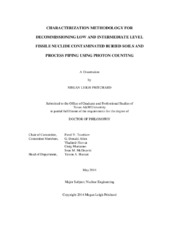| dc.description.abstract | A new approach to- and method for characterization of fissile nuclide
contaminated soils and process piping has been developed and implemented for low and
intermediate level wastes, using new calibration bases for photon counting. The method
has been validated by integrating the capabilities of MCNP5 and ISOCS for a LaBr
scintillator detector in combination with known radioactive standards. In addition, the
developed methods consider nuclear safety as the priority while retaining realistic fissile
mass and enrichment estimation techniques.
The impact of a quick, portable non-destructive assay process to the
decommissioning and remediation arena is extremely valuable. Traditional methods have
inherent limitations in time consumption, resources, stability, and rigidity. In addition to
optimizing a material blending and storage program, gaining a real-time understanding to
the nature of fissile material prior to disturbance aids a nuclear safety program and culture
invaluably.
In this dissertation, detailed detector-waste models were developed and utilized to
create a quick uranium mass and enrichment estimation process by taking advantage of
the resolution and discrimination capabilities of the LaBr equipped InSpector 1000
instrument. The analysis takes into account multiple possible scenarios that may be
encountered during decommissioning and remediation of a fuel fabrication and buried
nuclear waste facility, while keeping nuclear safety controls in mind.
As an inherent part of the process, the models were validated by performing a series of code-to-software and software-to-standard benchmarking procedures, which provided substantiation for use of the detector for the derived purposes, in addition to ensuring that the Monte Carlo-based calibration approach was conservative, as compared to other methods.
The scenarios analyzed for the calibration basis were selected based on historical knowledge and in-field experience at the Westinghouse Hematite Decommissioning Project.
The techniques developed in this dissertation offer a new characterization method for fissile material quantity and enrichment with a portable, passive non-destructive gamma assay system without relying on continual macroscopic system analysis. In addition, it provides early detection of large quantities of fissile material prior to exhumation or disturbance to enhance nuclear safety processes. This places the first priority on nuclear and radiological safety while preserving the time and money saving aspects of production-based projects. | en |


